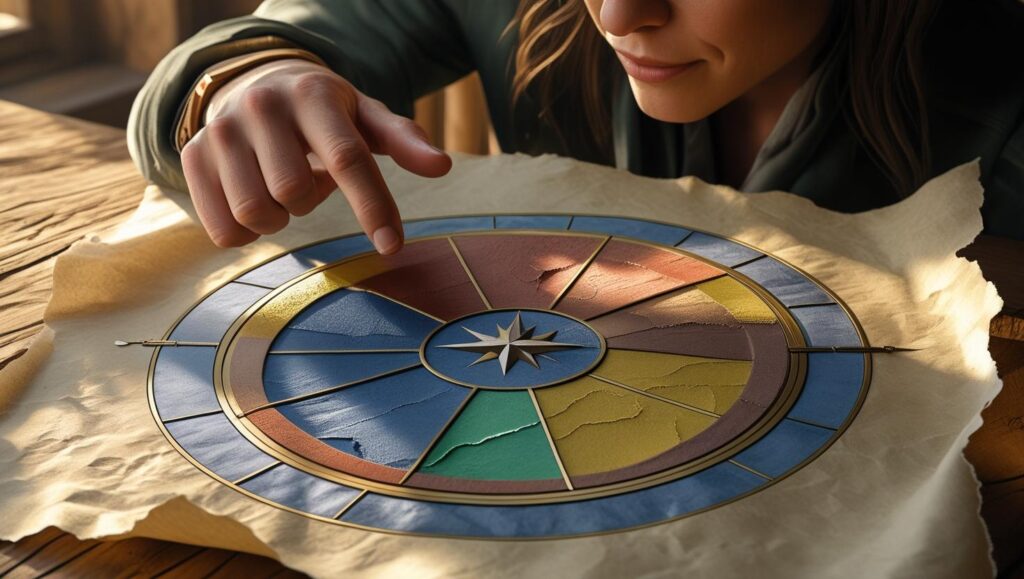
Why Beginners Struggle
Qi Men Dun Jia (奇门遁甲) is an ancient Chinese system of divination and strategy that can seem complex to newcomers. Many beginners struggle because the charts are multilayered, containing stars (九星), doors (八门), and gods (八神), all interacting within a palace system. Without understanding how these layers work together, it’s easy to misinterpret the chart and reach inaccurate conclusions.
Another challenge is timing. Each chart changes depending on the year, month, day, and hour, meaning even experienced practitioners must pay attention to when the question is asked. Beginners often try to read charts without aligning with these temporal cycles, leading to confusion.
This guide will break down the process step by step, showing beginners how to approach forecasting confidently and systematically. By following these steps, you can gain clarity and make informed decisions based on Qi Men Dun Jia insights.
Tools Needed

Before you begin forecasting, it’s important to gather the right tools:
- Qi Men Dun Jia chart software or templates – For beginners, using digital tools or pre-made charts simplifies the learning process. These tools automatically generate stars, doors, and gods positions based on date and time.
- Pen and paper or note-taking app – Writing down observations and interpretations helps track patterns and improves understanding over time.
- Calendar and clock – Timing is crucial. You need to know the exact hour, day, month, and year of the question or action.
- Reference guide or book – Beginners benefit from a reference listing stars, doors, and gods meanings to cross-check interpretations.
Having these tools ready ensures that you can focus on interpreting the chart rather than struggling with logistics. Even the most experienced practitioners rely on simple tools to maintain accuracy and clarity in forecasting.
Setting Intention

Before reading a chart, setting a clear intention is essential. Your intention focuses the question, ensures accuracy, and reduces confusion. Begin by clearly defining the subject and the outcome you are seeking.
For example, instead of asking, “Will I be successful?” ask, “Will this new business project launch successfully within the next month?” The more specific your intention, the easier it is to locate the correct palace and interpret the chart.
Meditation or brief reflection before casting the chart can help center your mind. By calming mental chatter, you allow the subtle energies indicated in the chart to be more easily understood. Think of this as tuning a radio; clarity improves when interference is minimized.
Finding Subject Palace

The subject palace is the starting point for any forecast. It is the palace in the 3×3 grid that corresponds to the person, question, or object in focus. Correctly identifying the subject palace ensures you are interpreting the right part of the chart.
Steps to find the subject palace:
- Determine the nature of your question (personal, business, health, relationship).
- Identify which palace aligns with your subject using a reference chart or software. Each palace represents a direction, area of life, or type of energy.
- Confirm the palace by checking its stars, doors, and gods for coherence with your question.
For beginners, it is easy to misplace the subject palace. One tip is to always cross-check the palace’s stars and doors with the theme of your question. For example, if asking about career advancement, a palace containing a Life Door (生门) with Tian Fu (天辅星) may indicate growth and guidance.
Once located, the subject palace becomes your lens for interpreting supportive and obstructive signs. Everything else in the chart is read relative to this palace.
Reading Supportive vs Obstructive Signs

After identifying the subject palace, examine stars, doors, and gods to determine whether the energies support or obstruct your goal.
- Supportive signs:
- Life Door (生门) and positive stars like Tian Fu (天辅星) or Tian Ren (天任星).
- Gods like Liu He (六合) or Jiu Di (九地) indicating cooperation, stability, or favorable conditions.
- Combined indicators pointing toward growth, opportunity, or assistance.
- Life Door (生门) and positive stars like Tian Fu (天辅星) or Tian Ren (天任星).
- Obstructive signs:
- Injury Door (伤门), Death Door (死门), or Dispute Door (惊门).
- Stars such as Tian Zhu (天柱星) suggesting conflict or disruption.
- Gods like Bai Hu (白虎) or Teng She (腾蛇) representing obstacles, risk, or hidden complications.
- Injury Door (伤门), Death Door (死门), or Dispute Door (惊门).
Beginner tip: Don’t panic when you see obstructive signs. They are warnings, not inevitabilities. Understanding these energies allows you to take precautionary action, delay decisions, or adjust your approach to maximize outcomes.
By comparing supportive and obstructive signs, you create a balanced forecast, identifying opportunities while mitigating risks. The interplay of positive and negative influences provides nuanced guidance rather than binary yes/no answers.
Case Study

A beginner client asked whether they should accept a new job offer. After preparing tools, setting intention, and locating the subject palace, the chart revealed the following:
- Star: 天辅星 (Tian Fu / Advisor Star) – indicating guidance, wisdom, and learning.
- Door: 生门 (Life Door) – supportive for growth and career advancement.
- God: 六合 (Liu He) – favorable alliances and cooperation.
Supportive signs clearly indicated that the job could provide mentorship, growth, and valuable connections.
However, obstructive signs were also present:
- Door: 伤门 (Injury Door) in an adjacent palace – warning of potential conflicts with colleagues.
- God: 白虎 (Bai Hu) – suggesting a competitive environment with possible challenges.
By analyzing the chart, the beginner practitioner advised the client to accept the offer but approach the workplace with caution and strategic planning, focusing on building alliances and avoiding unnecessary conflict.
After six months, the client reported that the job had excellent opportunities for learning and promotion, but they also navigated some initial interpersonal challenges, exactly as the chart predicted.
This case demonstrates that forecasting is about preparing for outcomes rather than guaranteeing them. By reading both supportive and obstructive signs, even beginners can provide meaningful guidance.
Tips for Beginners

- Start small: practice with simple, personal questions.
- Cross-check charts: confirm stars, doors, and gods align with the question.
- Take notes: record patterns and outcomes to improve interpretation skills.
- Be patient: forecasting is a skill refined over time.
Conclusion

Forecasting with Qi Men Dun Jia is a skill that grows with practice. By gathering tools, setting intentions, locating the subject palace, and reading supportive vs obstructive signs, beginners can generate meaningful guidance and strategic insights. Consistent practice builds confidence and accuracy in every reading.